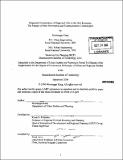| dc.contributor.advisor | Karen R. Polenske. | en_US |
| dc.contributor.author | Kang, Myoung-Gu, 1970- | en_US |
| dc.contributor.other | Massachusetts Institute of Technology. Dept. of Urban Studies and Planning. | en_US |
| dc.date.accessioned | 2007-07-18T13:01:25Z | |
| dc.date.available | 2007-07-18T13:01:25Z | |
| dc.date.copyright | 2006 | en_US |
| dc.date.issued | 2006 | en_US |
| dc.identifier.uri | http://hdl.handle.net/1721.1/37875 | |
| dc.description | Thesis (Ph. D.)--Massachusetts Institute of Technology, Dept. of Urban Studies and Planning, 2006. | en_US |
| dc.description | Includes bibliographical references (leaves 97-103). | en_US |
| dc.description.abstract | More high-tech firms are conducting their business over long distances due to the use of new information and communication technologies (ICT). However, regional scientists articulate that geographic proximity is still important, at least, to the high-tech industry and the knowledge-related business activities. My research offers a ground work for understanding the paradox - more dispersed high-tech business practices and higher geographic concentration of high-tech jobs in the new economy than before. Drawing from diverse regional and economic literatures, I suggest a paradox of new information communication technology regarding the location pattern of high knowledge-generating jobs. From this perspective, I found a dispersed concentration pattern of high knowledge-generating jobs due to less transitory tacit knowledge than codified knowledge and implicit communication; and business organization change. Both my longitudinal empirical analysis and interviews suggest that the jobs in the high knowledge-generating production industries in the United States became further concentrated during the 1990s. | en_US |
| dc.description.abstract | (cont.) During the same period, the jobs in the high knowledge-generating customer-oriented industries dispersed. In the former industries, producers are the major knowledge generators, while in the latter industries, tacit knowledge is derived mostly from the interaction between firms and customers. In consequence, the jobs in the former industries tend to agglomerate with each other, but the jobs in the latter industries tend to disperse in order to be close to customers. Furthermore, five out of the six high-knowledge generating production industries show a "winner-takes-all" kind of spatial monopolization of jobs. For example, in the computer industry, the ratio of the job share of Silicon Valley, the top share holder, and the job share of the Boston metro area, the second highest job share holder, increased from 1.6 in 1990 to 2.9 in 2000. However, this finding fails to explain the phenomenon of R&D units of advanced multinational high-tech production firms locating in remote developing and middle-income countries. | en_US |
| dc.description.abstract | (cont.) To answer this puzzle, I identify their actual activities and compare multinational and local R&D operations in Korea. Interviews reveal that they are closer to being customer-relations intensive units, although the R&D units of the multinational firms in Korea are labeled "R&D." They are conduits of outreach to local customers, which conduct (1) the flexible customization of their products to meet local customers' demands and (2) customer management and marketing in the highly competitive global market. | en_US |
| dc.description.statementofresponsibility | by Myounggu Kang. | en_US |
| dc.format.extent | 110 leaves | en_US |
| dc.language.iso | eng | en_US |
| dc.publisher | Massachusetts Institute of Technology | en_US |
| dc.rights | M.I.T. theses are protected by copyright. They may be viewed from this source for any purpose, but reproduction or distribution in any format is prohibited without written permission. See provided URL for inquiries about permission. | en_US |
| dc.rights.uri | http://dspace.mit.edu/handle/1721.1/7582 | |
| dc.subject | Urban Studies and Planning. | en_US |
| dc.title | Dispersed concentration of high-tech jobs in the new economy : the paradox of new information and communication technologies | en_US |
| dc.type | Thesis | en_US |
| dc.description.degree | Ph.D. | en_US |
| dc.contributor.department | Massachusetts Institute of Technology. Department of Urban Studies and Planning | |
| dc.identifier.oclc | 124144738 | en_US |
